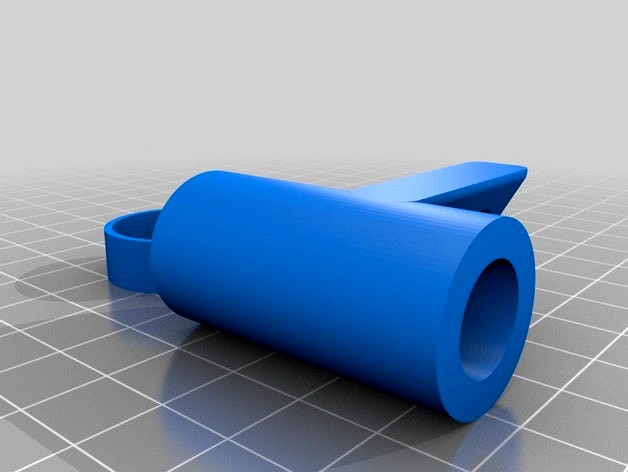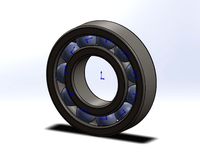Thingiverse

Perimeter Bear Alarm Fence by nenadr
by Thingiverse
Last crawled date: 3 years ago
This is a perimeter fence to sound an alarm if a large critter enters the camp. We generally use motion detectors, but they are not adequate for a polar 24hour sunlight scenario and well-insulated polar bears. The alarm on this fence sounds if either the circuit is broken or any fence poles are overturned.
I found the basic design on Jerry Kobalenko's website: http://www.kobalenko.com/ and Jerry also kindly answered my questions. Jerry's blog and books are an absolute goldmine of information if you plan a trip into high Arctic in general and to Ellesmere Island in particular. Books are an excellent read even for an armchair traveler - "Horizontal Everest" is full of fascinating history of Arctic exploration and "Arctic Eden" has some spectacular photography as well.
The fence is a wire strung over several carbon-fiber poles - I use eight. Mounted on each pole is a capsule containing a mercury switch that will break the circuit if a bear knocks the pole over. Capsules can be moved up or down depending on how deep the pole has been pushed into the snow. There are three 10 foot wire segments between each two poles. Wire segments are connected using small connectors. There is also a control box that has an USB cable for power, a mounted siren and and on/off switch. Use 40ft length of wire to connect the control box to the fence.
Each pole has a cap on the top and an arrow tip on the bottom. A tip holder is epoxied into the pole, so the tips can be replaced. While the fence has been designed for snow, the poles are quite sturdy and will easily go into ground. But see below about frozen gravel!
The printed parts are:
control box (called speaker base)
tilt housing (2 versions)
tilt housing lid
wand top cap
wand plug to aid in epoxying the arrow tip holder
My original tilt switch housing was vertical. However, there is a danger that the tilt switch won't interrupt if the pole does not fall completely over. My second version is tilted already and, if positioned so it's angled inward toward the camp, will activate even if the pole does not fall completely flat.
Some of the things use modules from my primitives library (https://github.com/imageguy/openscad_primitives), which I've added to this project - code assumes they are in ../libs/plib directory.
I am enclosing both .scad and .stl files. You are welcome to use and modify as you see fit. Each .scad file has comments and usage at the top that might prove helpful.
The speaker base box and the second version of the tilt switch have filleted edges. Sometimes these will turn out to be not watertight due to how the curved surfaces are joined by OpenScad. The STL files included here have been fixed, but I found that even "non-watertight" files sliced accurately.
Please see the "Fence Construction" for the bill of materials, electronic schematics and various pictures.
We used this fence on a five week ski trip out of Grise Fiord on Ellesmere Island in Nunavut. It worked really well, with very few false alarms, thought it fortunately never had to detect a real polar bear! Our original fence used 2/3 20Ga wire and 1/3 18Ga wire (I ran out of 20Ga). I took one segment of 22Ga stranded wire just to see how it behaved. While it was warmer than expected (I doubt that we ever went below -35C), 22Ga stranded wire performed well and I believe it would work fine at -40C. I've updated the bill of materials accordingly.
Here are a few other comments based on the trip.
Poles are sturdy, but do not hammer them, as I did, with wild abandon into frozen gravel - one of our poles split a little. I found that for snow and water ice (when camping on sea or lake ice), a good technique is to bring a block of wind-compacted snow and use it to set the pole.
The system of using twist-ties to jam the tilt switches onto poles at the right height did not work too well - the poles are just too smooth and I had perennial problems with switches sliding. Next time I'll add either heat-shrink tubing or some electrical tape to add friction. Jerry uses springs and heat-shrink to hold his tilt switches, but I'm hoping just adding a bit of friction will do the trick.
In strong winds, make sure your poles are solid - we had the fence make noise every few seconds one night, until I finally figured out one pole was swaying in the wind (really strong gusts) and the mercury in the tilt switch was sloshing around and braking contact.
I had a few solder joints fail, due to my poor soldering skills.
Three segments between each pair of poles was a good choice - had plenty of options to recover if any joints failed.
Using small banana connectors worked perfectly. No matter what you do, snow and moisture will get into the connectors. Small connectors are easy to melt out with your hand, even at below -30C. Though it's less than a fun activity, especially in the wind.
Connectors seem very resistant to moisture, no problems even in blowing snow. You probably don't need to encase them into heat-shrink, except to protect the solder joint.
I was careful to wire the tilt switches consistently. Looking from the inside of the fence, female banana connector was on the left wire, male on the right. Every wire segment had male connector on one end and female on the other.
Battery pack and solar cells worked great, but I might rework the controller to have micro USB socket instead of USB wire. Wire was too short to go to the cells, so I had to use the battery pack at all times and connect the pack to the cells using another wire.
It took over 30 min to set up the fence every day, more if the wire tangled or the snow was bad and I had to cut "plugs" to plant the holes. I found it easiest to connect the perimeter wire into a single run before coiling it up, it tangled way less than having 8 separate pieces. But it still took weeks before I got to the point I was really efficient with setting up and taking down the fence.
I found the basic design on Jerry Kobalenko's website: http://www.kobalenko.com/ and Jerry also kindly answered my questions. Jerry's blog and books are an absolute goldmine of information if you plan a trip into high Arctic in general and to Ellesmere Island in particular. Books are an excellent read even for an armchair traveler - "Horizontal Everest" is full of fascinating history of Arctic exploration and "Arctic Eden" has some spectacular photography as well.
The fence is a wire strung over several carbon-fiber poles - I use eight. Mounted on each pole is a capsule containing a mercury switch that will break the circuit if a bear knocks the pole over. Capsules can be moved up or down depending on how deep the pole has been pushed into the snow. There are three 10 foot wire segments between each two poles. Wire segments are connected using small connectors. There is also a control box that has an USB cable for power, a mounted siren and and on/off switch. Use 40ft length of wire to connect the control box to the fence.
Each pole has a cap on the top and an arrow tip on the bottom. A tip holder is epoxied into the pole, so the tips can be replaced. While the fence has been designed for snow, the poles are quite sturdy and will easily go into ground. But see below about frozen gravel!
The printed parts are:
control box (called speaker base)
tilt housing (2 versions)
tilt housing lid
wand top cap
wand plug to aid in epoxying the arrow tip holder
My original tilt switch housing was vertical. However, there is a danger that the tilt switch won't interrupt if the pole does not fall completely over. My second version is tilted already and, if positioned so it's angled inward toward the camp, will activate even if the pole does not fall completely flat.
Some of the things use modules from my primitives library (https://github.com/imageguy/openscad_primitives), which I've added to this project - code assumes they are in ../libs/plib directory.
I am enclosing both .scad and .stl files. You are welcome to use and modify as you see fit. Each .scad file has comments and usage at the top that might prove helpful.
The speaker base box and the second version of the tilt switch have filleted edges. Sometimes these will turn out to be not watertight due to how the curved surfaces are joined by OpenScad. The STL files included here have been fixed, but I found that even "non-watertight" files sliced accurately.
Please see the "Fence Construction" for the bill of materials, electronic schematics and various pictures.
We used this fence on a five week ski trip out of Grise Fiord on Ellesmere Island in Nunavut. It worked really well, with very few false alarms, thought it fortunately never had to detect a real polar bear! Our original fence used 2/3 20Ga wire and 1/3 18Ga wire (I ran out of 20Ga). I took one segment of 22Ga stranded wire just to see how it behaved. While it was warmer than expected (I doubt that we ever went below -35C), 22Ga stranded wire performed well and I believe it would work fine at -40C. I've updated the bill of materials accordingly.
Here are a few other comments based on the trip.
Poles are sturdy, but do not hammer them, as I did, with wild abandon into frozen gravel - one of our poles split a little. I found that for snow and water ice (when camping on sea or lake ice), a good technique is to bring a block of wind-compacted snow and use it to set the pole.
The system of using twist-ties to jam the tilt switches onto poles at the right height did not work too well - the poles are just too smooth and I had perennial problems with switches sliding. Next time I'll add either heat-shrink tubing or some electrical tape to add friction. Jerry uses springs and heat-shrink to hold his tilt switches, but I'm hoping just adding a bit of friction will do the trick.
In strong winds, make sure your poles are solid - we had the fence make noise every few seconds one night, until I finally figured out one pole was swaying in the wind (really strong gusts) and the mercury in the tilt switch was sloshing around and braking contact.
I had a few solder joints fail, due to my poor soldering skills.
Three segments between each pair of poles was a good choice - had plenty of options to recover if any joints failed.
Using small banana connectors worked perfectly. No matter what you do, snow and moisture will get into the connectors. Small connectors are easy to melt out with your hand, even at below -30C. Though it's less than a fun activity, especially in the wind.
Connectors seem very resistant to moisture, no problems even in blowing snow. You probably don't need to encase them into heat-shrink, except to protect the solder joint.
I was careful to wire the tilt switches consistently. Looking from the inside of the fence, female banana connector was on the left wire, male on the right. Every wire segment had male connector on one end and female on the other.
Battery pack and solar cells worked great, but I might rework the controller to have micro USB socket instead of USB wire. Wire was too short to go to the cells, so I had to use the battery pack at all times and connect the pack to the cells using another wire.
It took over 30 min to set up the fence every day, more if the wire tangled or the snow was bad and I had to cut "plugs" to plant the holes. I found it easiest to connect the perimeter wire into a single run before coiling it up, it tangled way less than having 8 separate pieces. But it still took weeks before I got to the point I was really efficient with setting up and taking down the fence.
Similar models
cg_trader
$10

Fence segment pole
...or games / ar/ vr. can be used for creating indoor and outdoor environments. fence low pole poly rope segment wooden wooden fence
cg_trader
$10

Fence segment pole
...or games / ar/ vr. can be used for creating indoor and outdoor environments. fence low pole poly rope segment wooden wooden fence
cg_trader
$10

Fence segment pole
...use for games / ar/ vr. can be used for creating indoor and outdoor environments. fence low pole poly segment wooden wooden fence
cg_trader
$10

Fence segment pole
...use for games / ar/ vr. can be used for creating indoor and outdoor environments. fence low pole poly segment wooden wooden fence
cg_trader
$10

Fence segment pole with rope
...or games / ar/ vr. can be used for creating indoor and outdoor environments. fence low pole poly rope segment wooden wooden fence
cg_trader
$10

Fence segment pole with rope
...or games / ar/ vr. can be used for creating indoor and outdoor environments. fence low pole poly rope segment wooden wooden fence
thingiverse
free

RC Model canopy latch by itain
...teel rod. each brass connector is cut in two and each part is filed to about 3.8mm. the spring is winded from 0.33 mm music wire.
thingiverse
free

Antenna pole tops by dhg864
...r pole? these poles are for 2.5mm and 20mm top segments.
they fit over the top of the pole and have two mounts for zip ties each.
thingiverse
free

Bullet Fence Pole Top by markhd
...icken wire for my chicken run. i've designed a number of pole toppers to help hang the chicken wire on them (see cactus top).
3dwarehouse
free

Arctic landscape
...rth pole is a sea surronded by land. polar bears dominate the arctic. the arctic ocean is also the smallest and shallowest ocean.
Nenadr
thingiverse
free

OneUp/TwoUp wire bundle guide by nenadr
...naps onto the bottom part..the upright is offset to the right, so it clears the top of the x gantry for x=0.
model in freecad.
thingiverse
free

TwoUp V2 nut holder by nenadr
...the original holder's too flimsy, and the hex nut hole is too large. i've made it beefier, with a better nut holder hole.
thingiverse
free

Simple harness for Nexus 5 by nenadr
...s and do a fairly minimal editing.
i place no restrictions on the use of this code - you are welcome to do what you like with it.
thingiverse
free

GoPro clip mount by nenadr
...d_primitives) and as a thing
(http://www.thingiverse.com/thing:1679551).
please feel free to use, share as modify as you see fit.
thingiverse
free

Plumbcheck gizmo to verify X-Y-Z axes are orthogonal by nenadr
... all the angles were 90 degrees.
the end of the x axis of the gizmo is cut off to mark it, so i would know which axis is which.
thingiverse
free

OneUp - TwoUp Z axis range extender by nenadr
... wires between the gantry and the handle. if you route the wires above the handle, you only need a 15mm shim.
model in freecad.
thingiverse
free

Box for Canon SX700HS Camera by nenadr
...y with certain cavities i placed in around battery holder to reduce the weight.
please fell free to use or modify as you see fit.
thingiverse
free

Filament spool bearing by nenadr
...
obviously, you will need two of each piece to mount a spool.
model in freecad. you're welcome to use and modify as you like.
thingiverse
free

openSCAD Primitives Library by nenadr
...n a 2x2x2 array in a hopefully intuitive fashion.
i maintain this code on github: https://github.com/imageguy/openscad_primitives
thingiverse
free

Small quick release clamp by nenadr
... make each jaw.
i put no restrictions on this design and related code. you are welcome to use, share or modify it as you see fit.
Alarm
archibase_planet
free

Alarm
...alarm
archibase planet
equipment alarm
alarm ipod - 3d model (*.gsm+*.3ds) for interior 3d visualization.
3d_export
$5

Alarm Clock
...alarm clock
3dexport
alarm clock
3d_export
$5

Alarm Clock
...alarm clock
3dexport
alarm clock
turbosquid
$19

Alarm
...
royalty free 3d model alarm for download as ma, obj, and fbx on turbosquid: 3d models for games, architecture, videos. (1151100)
turbosquid
$20

Alarm
... available on turbo squid, the world's leading provider of digital 3d models for visualization, films, television, and games.
turbosquid
$18

Alarm
... available on turbo squid, the world's leading provider of digital 3d models for visualization, films, television, and games.
turbosquid
$15

Alarm
... available on turbo squid, the world's leading provider of digital 3d models for visualization, films, television, and games.
3d_export
$5

alarm clock
...alarm clock
3dexport
alarm clock made in the style of mid-century modern
design_connected
$9

Alarm Clocks
...alarm clocks
designconnected
karlsson alarm clocks computer generated 3d model. designed by holland vormgevers.
archive3d
free

Alarm 3D Model
...l
archive3d
equipment alarm
alarm ipod - 3d model (*.gsm+*.3ds) for interior 3d visualization.
Perimeter
3ddd
$1

Blu Dot / Perimeter Floor Lamp
...erimeter floor lamp
3ddd
blu dot
• powder-coated steel base
• oversized grey or white cloth lampshade
• 80” cloth-covered cord
3d_export
free

V-Tower
...small and simple tower with a fence around the perimeter ...
3d_export
$30

Sandbags Wall Construction Kit 3D Model
...bags cover military game desert wall protection bunker fort perimeter flood defense barrier sandbags wall construction kit 3d model...
3d_export
$180

Fantasy Castle 3D Model
...fantasy fiction walls turrets battlements moat drawerbridge bridge chains perimeter water stone fantasy castle 3d model midnight oil 27711...
3d_export
$29

Guard tower 3D Model
...prision military look ladder railing metal soldier base wood perimeter iraq prisoner 3d model max vray guard tower 3d...
3d_export
$14

Bar stool - 2803
...- 911mm - seat height - 725mm - common perimeter - 400х511mm multiformat: igs; obj; stl; step; x_t; x_b;...
3d_export
$10

twisted lamp
...twisted lamp 3dexport printed the shade part with a perimeter of 2, and layer height of 0.2mm, took 10...
3ddd
$1

Casa Spazio Limes
...and sectionals unique backrest panels attached to the entire perimeter of the base enable the shape of the sofa...
3d_export
$53

circular heliport
...the model includes an oscillating fire monitor, bladdertank, elevated perimeter light, inset light, floodlight, chapi unit and a wind...
3d_export
$53

octagonal heliport
...the model includes an oscillating fire monitor, bladdertank, elevated perimeter light, inset light, floodlight, chapi unit and a wind...
Fence
archibase_planet
free

Fencing
...fencing archibase planet fencing fence barrier fencing - 3d model for interior 3d...
archibase_planet
free

Fencing
...fencing archibase planet fencing barrier fence fencing - 3d model for interior 3d...
archibase_planet
free

Fence
...fence
archibase planet
rail fence barrier fencing
end fence - 3d model for interior 3d visualization.
3d_export
free

fence
...de of branches and sticks, a new fence made of boards, an old fence made of boards. pivots are applied to the gate for animation.
archibase_planet
free

Fence
...fence
archibase planet
fence barrier fencing
fence-2 - 3d model (*.gsm+*.3ds) for interior 3d visualization.
archibase_planet
free

Fence
...fence
archibase planet
fence fencing enclosure
fence-6 - 3d model (*.gsm+*.3ds) for interior 3d visualization.
archibase_planet
free

Fence
...fence
archibase planet
fence barrier fencing
fence-7 - 3d model (*.gsm+*.3ds) for interior 3d visualization.
archibase_planet
free

Fence
...fence
archibase planet
fence fencing barrier
fence 4 - 3d model (*.gsm+*.3ds) for interior 3d visualization.
3d_export
$5

fence
...fence
3dexport
lawn fencing
3ddd
$1

FENCE
... ковка , ограда , перила
fence
Bear
3d_export
$6

Bear
...bear
3dexport
bear
3d_export
$5

bearing
...bearing
3dexport
bearing
3d_export
$12

bear
...bear
3dexport
bear for 3d printing toy
3d_ocean
$9

Bearing
...ne ball ballbea bearing bearings engine hard industrial machine mechanic metal part piece plastic ring screw sphere steel
bearing
archibase_planet
free

Bear
...bear
archibase planet
statuette bear picturesque element
bear - 3d model (*.gsm+*.3ds) for interior 3d visualization.
3d_export
$5

bear
...bear
3dexport
bear have a stl.,3dm files
archibase_planet
free

Bear
...bear
archibase planet
bear animals omnivorous animal
bear angry n250907- 3d model (*.gsm+*.3ds) for interior 3d visualization.
archibase_planet
free

Bear
...bear
archibase planet
bear animals omnivorous animal
bear easy n250907 - 3d model (*.gsm+*.3ds) for interior 3d visualization.
3ddd
$1

Teddy bear
...teddy bear
3ddd
teddy bear , медведь
teddy bear :)
3d_ocean
$12

Bear
... formats. created with 3d max 9.0. this file is very useful for learning & rigging. it can be used for any professional work.
